Crossing from Portugual to Lanzorote
Wow. That was a complicated and wonderful several days. Also, sooooo do not recommend having Norwalk Virus rip through the boat just after setting out on a 100 hour crossing.
“There’s a lot to unpack here”, as they might say in talk-therapy.
First up: the technical fundamentals — the conditions were fine, and the boat didn’t break a sweat handling them. Nothing unusual was required to get the boat from point A to B. Sailing across the open sea, 10 hours out from land, will never be as safe as watching TV from the comfort of a well-stocked nuclear fall-out shelter, but by marine standards, we were safe (even if we could be neither comfortable nor in good cheer).
Second, the geography of what’s up. If you want to get from the Mediterranean Sea to the Caribbean (as Otoka plans to do), like Christopher Columbus and countless other ships before, this southern Crossing route is standard. There is a giant current, and regular airflow down the Atlantic coast of Spain, Portugal, and Africa, which then turns West around the Canaries and pushes you up against Barbados, 2600 nautical miles later. A guy literally sealed himself in a large barrel with lots of provisions, had himself set adrift in this flow, and successfully completed the voyage, driven by ocean currents alone (no word on how the folks in Barbados survived meeting this fellow, fresh-out-of-his-shower-free barrel). In other words, if you had lots of food, you could probably lose your mast, rudder, radios, and engine, and still cross the Atlantic “just fine”. In any event, the first step is to get down to the Canaries.
From the southern coast of Portugal / The Strait of Gibraltar, it’s 600 nautical miles (nm) mostly south down Africa, and there are 1.8 km in a Nautical Mile. Nautical Miles are still a thing because they match exactly with the degrees of latitude that we use to divide up the world.
So, for us, we are talking about a journey of 1200 km, in a vessel that goes around 12 km/hour.
As a newbie to sailing, my approach has been to soak up everything I can, and then find opportunities to take the initiative and if I’ve got it right. Before this, I’d some hours day sailing, and the two 24 hour transits from Almerimar to Gibraltar, and the Gibraltar to Portugal — both those were quite calm, and the day sailing was rough — higher winds, frequent tacking, etc.
One thing to keep in mind is that “4 day crossing” means approximately 4 x 24 hours. One way or another, continuous attention for about 100 hours needs to happen. That’s about two-and-a-half Working Weeks for folks who think in terms of 8 hour workdays. A sister boat that made the crossing with us, Vesna, started back in Almerimar, and ran for 6 days before arriving at Lanzorote. That’s about 144 hours, or 3.5 working weeks of hours.
This jump had been planned, researched, discussed at length for ages; metrics for what constitutes a good window were established (see earlier blog post), and a window was upon us. It wasn’t perfect: the swells were marginally more than we’d like, the winds a little on the low side. We were also hoping to travel with Vesna, but they hadn’t made good time approaching Gibraltar, and their window for getting through the Straight of Gibraltar was closing fast. If they didn’t make it through overnight, they would likely have to remain in the Med for another couple weeks. We decided to wait for the next round of forecast updates in the morning, and decide whether to make the jump then.
Morning arrived, and we learned that Vesna had made it through the Strait to the clear sailing in the Atlantic. The weather forecast was now suggesting that our current window could be the last window for a while. With Vesna here, and the weather still looking good, we decided to go for it.
In the meantime, that morning, I’d started feeling a bit off, but believed it was a touch of food poisoning. I’d had a treat in town that nobody else had, and thought maybe I’d chosen poorly. I reckoned I could be ill at sea just as ably as I could at anchor; either way, I’d just be hanging out on a boat.
So, off we go. We have a bail-out point just north of the Strait, that we can divert to if the conditions aren’t good.
It is not until *after* the bail-out point that the facts coalesce, and it becomes completely, disgustingly, clear that we have Norwalk Virus or similar onboard. We each have a personally curated slice of hell to cope with, individually and collectively, for the next 24-48 hours. Oh, and a boat to run 24/7 in the meantime.
The swells in the Atlantic off the coast of Africa are large and long, coming at us from an angle behind us (from Starboard) and our course requires us to crab across them, for the entire transit. Our boat has a short, nimble, keel (fantastic in tight harbours!), so it doesn’t track a straight line through them — it swings widely back and forth while doing an “S” curve and a smaller rock forward-and-back as these waves roll across our path. For anyone even slightly susceptible to motion sickness, these conditions would do just fine to trigger upset, nevermind while in the grips of a virus that liquifies the GI tract. In my case, I worked out a schedule of taking Gravol before going to rest, so that the soporific effects would fade (but it would still be effective) for my next watch.
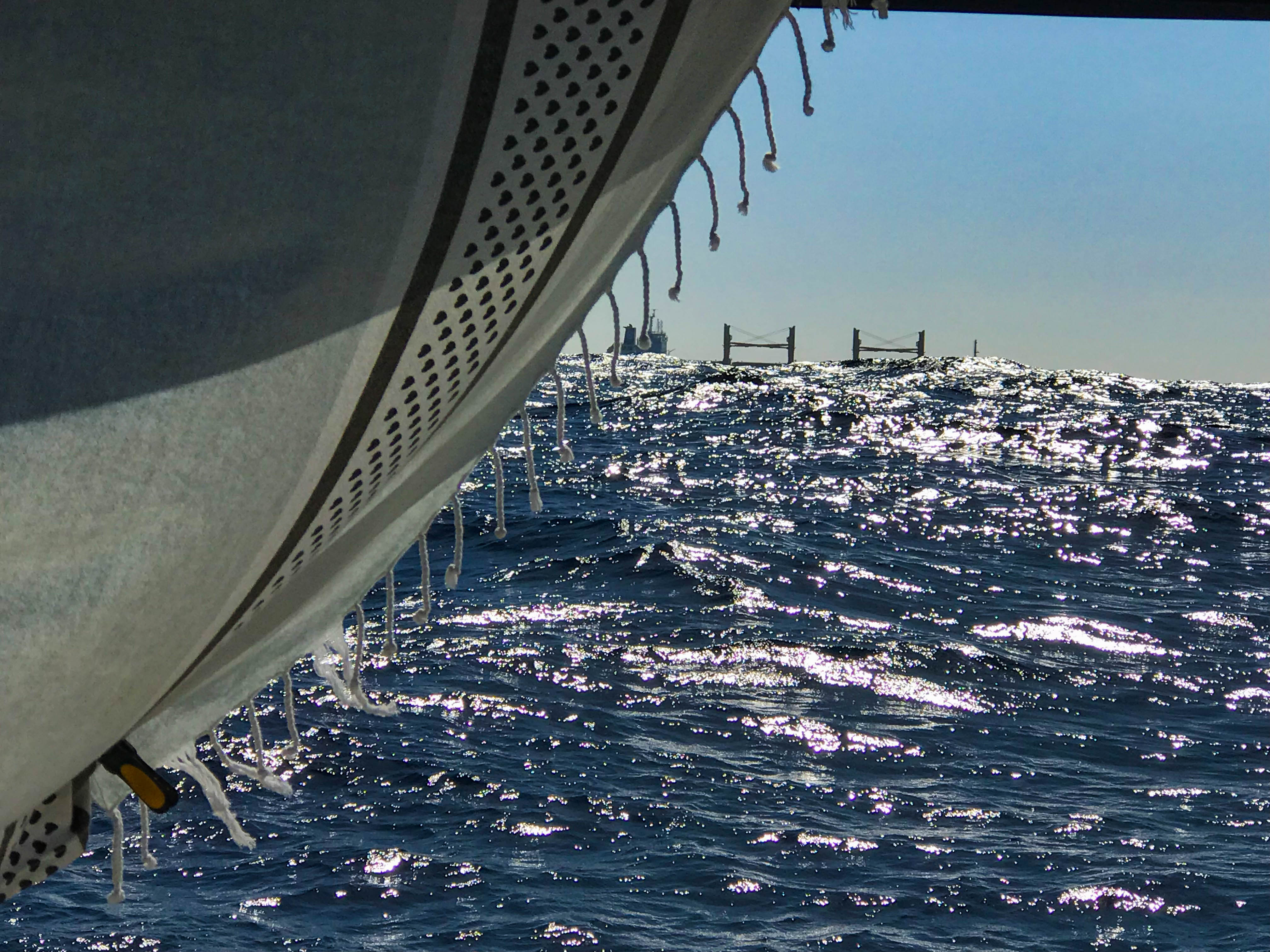
After a couple of days, the body usually acclimatizes to the constant motion, I’m told, so I was hoping Gravol wouldn’t be needed for the whole crossing, but I spent the third day attempting to resolve a bit of heart-burn using Gravol… As I felt the antacid take nearly instant effect, I reflected on how nice it would have been to have tried that many hours earlier, as I was able to finally leave Gravol behind.
Turns out that it is completely possible to become accustomed to the motion, and find yourself just lounging in the cockpit, watching the waves roll by, speculating on the particular, ineffable shades of blue and white, keeping an eye for a porpoise fin, sipping a fresh cup of tea, while a niece engages you in an ongoing conversation, the details of which fade from memory, yet is priceless. We did get there.
Although the boat is not technically ideal nor purpose-built for such crossings, I’m told Bavarias are the first or second most common boats to do these crossings — “not ideal” is more a comment on comfort than safely, and, as one friend put it — boats that are ideal for doing crossings can be awkward to actually cruise around in; do you want to spend years in comfort, and have a relatively uncomfortable crossing or two (many sailors, perhaps including my family here, will only ever do a couple of major crossings in their entire lives), or a great crossing, and the rest of your sailing living in an ungainly tank?
Since the illness stepped through our ranks, rather than hitting everybody at the same time, we ended up being able to staff the watches fully. It just forced each us to do a much more complete job of running the boat while doing our shifts. However, being low on energy also guides one to making simpler, risk-adverse choices.
Consider being ill, exhausted, knowing you are poorly co-ordinated and unpracticed in these sea states and contemplating spending 20 minutes+ out on the bow rigging up the Genoa Pole so that you can get enough wind angle to sail? We got that out on the 3rd day, and it was glorious, but no way could we have safely done it sooner.
A couple interesting points about motion sickness — you can reset; lie down, close your eyes, get some sleep, and you should awake just fine, and have a chance to get ahead of it — take some medication, give it a chance to kick in before you get up and start using your eyes. Enclosed spaces, reading, detail work — all increase the odds of triggering it. Being topside with an eye on the horizon, keeping a part of your mind tracking what the boat is doing so you can mentally anticipate minimizes the chances of triggering it.
When I was composing messages on the Satellite Transceiver, I would do a few letters, look up, then do a few more. It could take forever to get a message done. I didn’t read any books, no games on the phone, didn’t open the computer even once or attempt to type any thoughts. I listened to some downloaded music in my bunk, but that was about it.
But enough about trials — there is so much good stuff in the crossing as well.
The Atlantic has a reputation — as Canadians raised on stories rolling in from the east coast about the North Atlantic – Cold, Driving Winds, 60 Foot Waves, Snow Across the Maritimes That You can Lose Whole Houses In, Ice Bergs bumping around — “being out in the Atlantic” has a certain visceral feel to it. “Yes, we were out sailing in the Atlantic, no big deal” can sound a little like “Well, I was just moseying up Mt. Everest; it was getting a wee nippy, so I put my touque on, eh…“, but then you find yourself down on the southern side of Spain and Portugal, in 25-30 degree C days, slathering on sunblock, and, well… it’s got weather reports just like the Med, and in fact, in some ways is much less fickle than the Mediterranean.
Anyway, we were able to do our run in absolutely consistent conditions, materially close to predictions. We did our run sitting topside wearing shorts and t-shirts, and basic full-length clothing at night. We had no water over the bow or sides of the boat — though we did have a couple flying fish and a small squid come aboard — one fish jumped out of a wave, and ran right into our boom, dropped through the companion-way into the cabin of the boat, and seemed quite puzzled by what-the-hell-just-happened. We had dragon-flies come for visits.

I saw a big whale — it didn’t breach, but I was on watch, eyeing the horizon, when this giant fluke in the middle distance lifted itself out of the water, silhouetted against the sparkling water, and then slipped below again.
We saw a pack of dolphins or porpoises with very round heads pass our boat; nothing in our Big Book of Whales and Dolphins seems to quite match exactly though. We saw dolphins at least two other times, but less clearly.
At times, sea birds would come and inspect our boat for fishing-related program activities. Seeing none, they’d become instantly bored, and leave.
The nature of the blue of the water seemed different than the Med, and quite beautiful. Pictures do not quite do it justice.

See what I mean?
Being off-shore, being many nautical miles from the nearest anything, seeing this seascape in constant motion, at times unable to see the horizon for the waves, at others, on the crest of a swell, looking down at what appeared to be a vast lunar landscape seen through an improbably lovely blue-filter, and the teeming of life in it, gave me a sense of this entire thing being a whole world in itself, our boat a little life-support system skittering across it. We require these oceans and seas to live as a species, but they surely don’t require us!
I was at Ripley’s Aquarium in Toronto the other year; I remember after seeing all these amazing animals, seeing some the vast mechanical infrastructure that kept those habitats going; being out in the ocean made me feel like I was one of those fish at the aquarium, getting a glimpse of the life-support system that keeps me alive.
Another unexpected joy was the sensation of lying in the boat, half-awake, and how you could feel every bit of its motion through the water as it drifted, twisted, knocked, rolled, pitched, rose, and fell on it’s path through the ocean. There would be surprisingly long periods where it would be almost entirely still, with just feathery motions to and fro, then start sequences of large, deliberate motions. It reminded me of how movements in organ music repeat, evolve, get co-opted by other themes, reform on earlier themes, and so on.
I like systems that are truly random, but bounded by physics to *have* repeat materially the same motions — the boat can only pitch or roll so much before it *must* start to roll or pitch the opposite way, after all, but that movement back can be interrupted early, or run long, our have other factors get added at any point, and the fluid dynamics of the water have choatic elements that make it impossible to model the system past points that we can only determine approximately.
On a technical front, the chance to show some initiative with the boat systems was really rewarding; being able to have crewmates go to bed with confidence that all would be handled right on your watch is priceless. I’ve been at least leveled up to “reliable helper”!
For our closing note to enjoy and ponder, I’m not sure why these sculptures in the water seemed so appropriate, but they somehow seemed like a perfect welcome to port as we rounded the last corner into the harbour in Arrecife:
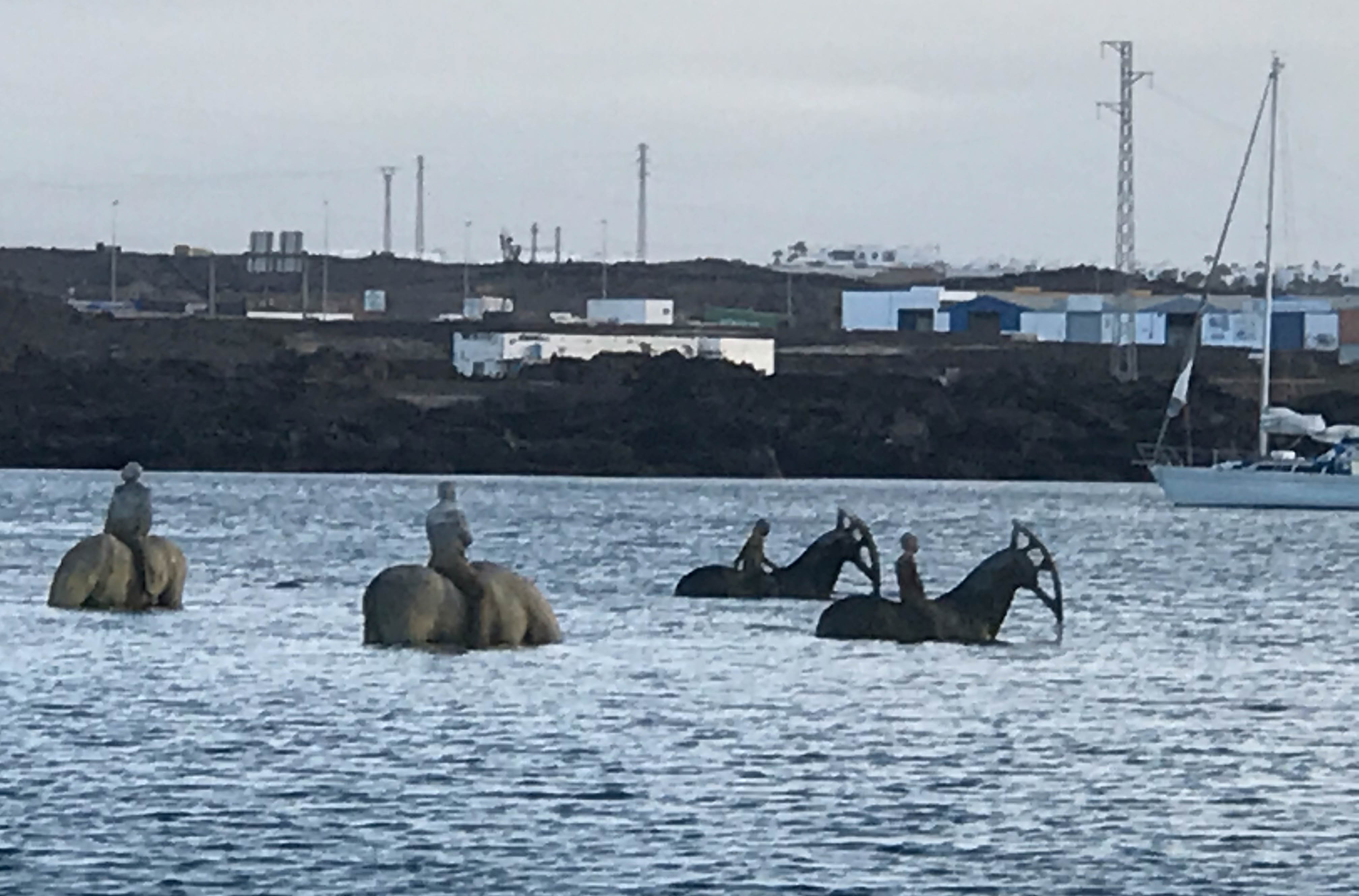
-C

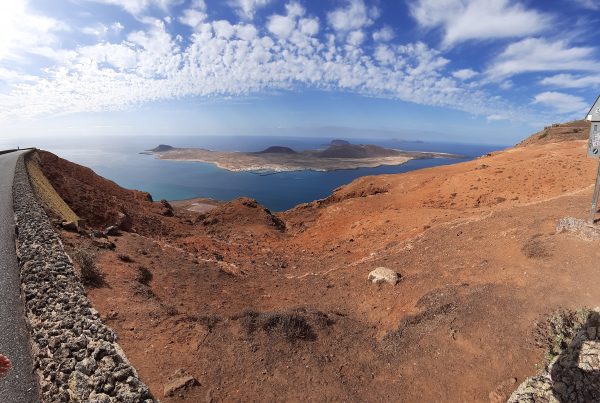
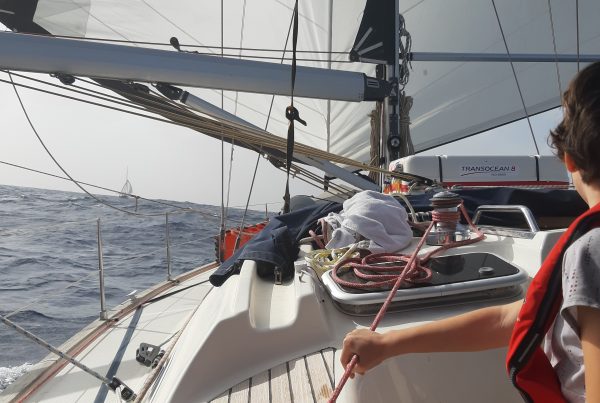


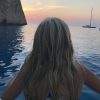
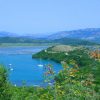
good passage.
I spent seasons on the North Atlantic is a 35 foot fishing boat. Extraordinary to experience; equally so to survive. The right whales dwarfed us and the fog required an uncanny sense of direction to make the return to Baie St Anne’s wharf, the boat sluggish and deep in the water with 25 tones of herring.
When is the next big hop. “Festival” in Trinidad?